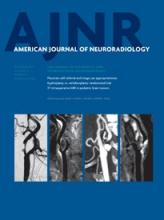We read with interest the article by van der Jagt et al1 describing the visualization of the scala media of the cochlea in living human subjects by non-contrast-enhanced T2-weighted imaging at 7T. For recognition of the scala media with this technique, visualization of the Reissner membrane is necessary. The Reissner membrane is very thin, 4–12 μm.2
Visualization of this thin membrane in a human cadaveric specimen has been reported by using microfocus x-ray CT with 12.2-μm spatial resolution and a 9.4T small-bore MR imaging unit with 23-μm spatial resolution.2,3 The spatial resolution used in this article on a 7T system was 300 μm. The presumed Reissner membrane shown in Fig 2 is not clear. Furthermore, there are several stripelike artifacts in the vestibule in Fig 2B.
To further increase the confidence and significance of this article, verification of the visualization of the Reissner membrane by comparing non-contrast-enhanced T2-weighted imaging and contrast-enhanced FLAIR4 in the same subjects might be very valuable. If the visualization of the Reissner membrane by non-contrast-enhanced MR imaging at 7T is feasible, it might be a “killer application” for its widespread use in the clinical field.
- © 2014 by American Journal of Neuroradiology












